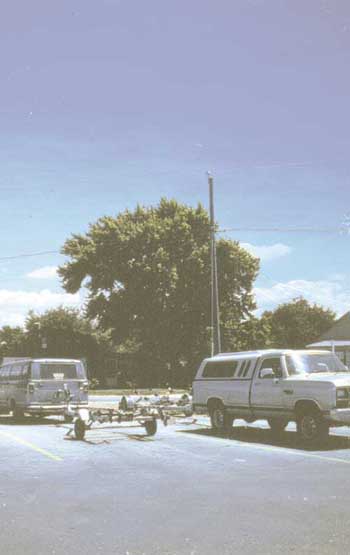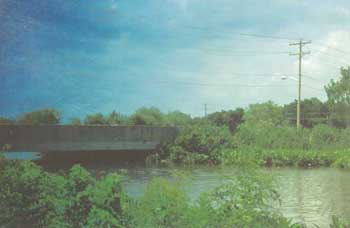About fifteen years ago, on a beautiful Saturday in September, my then nine-year-old son and I had just finished a wonderful day of sailing. Five hours earlier, when we put in at a new boat ramp, there were very few cars with trailers in the parking lot because the stiff wind was scaring the power boaters away. When we arrived back at the ramp, the parking lot was almost full. As I pulled my boat out of the water, I had to park on the far side of the parking lot well away from the water. As I pulled into the parking space to down rig the mast, I noticed a power line between the front of my car and the adjacent roadway. The high voltage conductors seemed too low for their location adjacent to an area that the National Electrical Safety Code (NESC) would clearly define as an established boat ramp and associated rigging area.

Photo 1. The utility quickly replaced the poles with taller ones. Photo 1 shows the line before it was corrected.
As my son and I lowered the short mast of our day sailor well away from the power line, another family backed their 22-foot day sailor into the parking space next to ours. I asked the man the length of his mast. He replied twenty-nine feet as he and his wife and two children prepared to raise the mast. I identified myself as an engineer with an electric power company and called his attention to the high voltage power line directly above the stern of his sailboat. If he raised the mast, it would surely hit the phase conductor. He acknowledged the hazard and then got irritated at me because he now had to move the trailer.
The next day, I contacted the utility and inquired about the line. The utility was not aware of the new boat ramp. The clearances were fine for a line along a coastal road, but they were dangerous next to a boat ramp. The people who built the boat ramp had created the hazard when they did not contact the utility. The phase conductor was only 24 feet above the ground. The utility quickly replaced the poles with taller ones. Photo 1 shows the line before it was corrected. The NESC minimum clearance of conductors over boat ramps and associated rigging areas is a function of the minimum clearance over the adjacent water.

Photo 2. Photo 2 shows an example of an obstruction that would prevent the passage of a sailboat.
The minimum clearance of conductors over water is covered by Rule 232 (page 71) and rows 6 and 7 of Table 232-1 (page 78). An “unobstructed surface” is a body of water where there is no fixed bridge or other obstruction preventing large sailboat access from a larger body of water. The larger the surface area of the body of water, the higher the clearance. For rivers, streams and canals, the surface area shall be the largest surface area of any one-mile segment that includes the crossing (Footnote 19). If a river, stream or canal has an unobstructed connection to a larger body of water, the clearance shall be based upon the water surface area of the larger body of water. Photo 2 shows an example of an obstruction that would prevent the passage of a sailboat. In photo 2, the power line crossing is actually between two fixed bridges 500 feet apart. The water surface area is less than 20 acres and thus the minimum clearance over that body of water is only 20.5 feet for phase conductors up to 22 kV phase to ground. If the body of water on the power line side of the bridge was directly connected without obstruction to the ocean, then the minimum clearance becomes 40.5 feet for phase conductors up to 22 kV to ground. Drawbridges are not considered obstructions. For bodies of water where the water level is controlled, the surface area and corresponding clearance shall be based upon the design high water level (Footnote 17). For bodies of water where the water level is not controlled, the surface area shall be that enclosed by its annual high-water mark. The clearance shall be based upon the normal flood level. If available, the 10-year flood level may be assumed as the normal flood level (Footnote 18). Note that some utilities have run into problems crossing shallow streams that become deep rivers at flood level. During storms, people out in sailboats often go up rivers to find a safe haven to weather the storm. Let us hope that they don’t find out in a flash that it wasn’t the safest move.
For boat ramps and associated rigging areas, the minimum clearance is specified in Rule 232 and in row 8 of Table 232-1 to be five feet greater than that specified over water in row 7. For the ramp and rigging area I spoke of previously, the minimum clearance for a 25 kV line (14,400-volt phase to ground) is 45.5 feet since the body of water next to the ramp is a river connected to the Atlantic Ocean.
The minimum clearances shall be met when the conductor is under maximum sag conditions. The three conditions that can create maximum sag conditions are spelled out in Rule 232A1, 2, and 3. The clearance shall be met with the conductor temperature of 120°F. If the crossing is designed for a maximum operating temperature exceeding 120°F; the clearance shall be met at the maximum operating temperature. In the medium and heavy loading districts, the clearance shall also be met when the conductor is at 32°F, with radial thickness of ice as specified in Rule 250B for the district.
National Electrical Safety Code® and NESC® are registered trademarks of the Institute of Electrical and Electronics Engineers.














Find Us on Socials